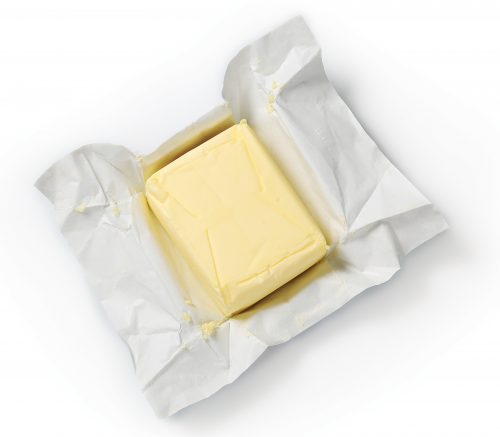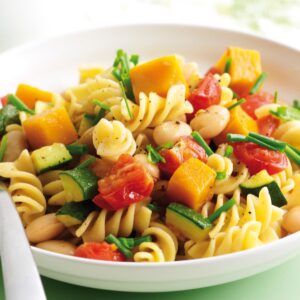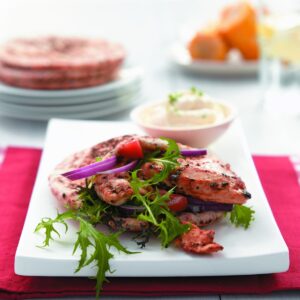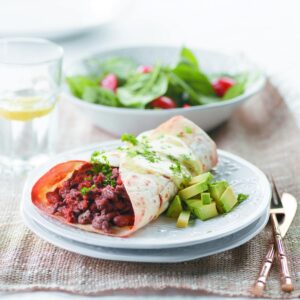
Fat is a hotly debated topic right now, and a confusing one. One of the criticisms often pitted against registered nutritionists and dietitians is that their thinking on fat is outdated – that they promote a low-fat diet. But this simply isn’t true. The science shows dietary fat plays a vital role, but does it mean we should all slather on the butter to our heart’s content (or discontent)?
Healthy Food Guide’s position on fat
We don’t promote a low-fat diet. In fact, there are fats we love. We do recommend keeping an eye on how much saturated fat you’re eating.
One of the easiest ways to keep within the recommended daily limit for saturated fat is by using low or reduced-fat dairy products. That is why our recipes tend to feature these in the ingredients – to make it easier for you.
Sometimes a small amount of a high-fat ingredient, such as butter or pastry, would be fine to use but we tend to steer clear of these in our recipes so you’re not left with the remainder sitting in your fridge after you’ve made the dish.
But, if your diet is low in saturated fat overall, you can probably afford to enjoy a bit of butter on your toast or drink blue milk.
Key points
Fats are vital to every cell in your body and to you getting vitamins A, D, E and K.
Not all fats are created equal. Unsaturated fats, like those found in plant foods and their oils, or in oily fish, are needed for optimal health.
We need to limit saturated fat, such as the fat found in meat, full-fat dairy, and coconut and palm oils for better heart health.
Healthy Food Guide recipes call for low or reduced-fat dairy products because this helps keep the overall saturated fat in a meal and across your day down.
Why do we need to limit saturated fat?
- Strong link to increased risk of heart disease.
- Replacing saturated fats with unsaturated fats improves blood cholesterol profiles.
Saturated fat comparison
- 1 tablespoon butter = 7.0g sat fat
- 1 tablespoon 55% fat spread = 1.9g sat fat
- 1 tablespoon coconut oil = 11.6g sat fat
- 1 tablespoon olive oil = 2.3g sat fat
Easy ways to reduce saturated fat
Use oil (not coconut) and reduced-fat versions of spread, coconut milk and dairy products.
When it comes to meat, choose lean cuts and trim visible fat off; remove skin and fat from chicken; and limit high-fat processed meats such as salami or pastrami.
There is room for saturated fat in our diets
The advice is to get no more than 10 per cent of your energy (kilojoules) from saturated fat, so in an 8700kJ day that means up to 24g.
We’re not anti-fat but we do like swapping fats
When we reduce the saturated fat in our diets we are better off trading it for good fats, rather than highly processed carbohydrates, such as cakes and pastries.
The low or reduced-fat products in our recipes are mostly to limit saturated fat but sometimes they’re to manage the total kilojoules. You can see that most of our main meal recipes are less than 8g saturated fat and 2500kJ per serve.
More about our recipes
We manage our recipes’ key components, especially kilojoules, saturated fat and sodium; juggling ingredients to keep within our guidelines.
Cottage cheese is naturally low in fat but, in some recipes, we use reduced-fat cottage cheese and, in others, we use the regular version, depending on how much room there is for more saturated fat.
Parmesan is a high-fat cheese, so it is high in saturated fat, but it is also high in flavour, meaning you can use less to more effect.
We aim to limit the kilojoules in our baking and sweets by limiting the total fat, as well as the sugar, because there are better sources of energy and good fats than treats.
High-fat foods we love
- avocado
- nuts
- seeds
- nut and seed oils
- oily fish
High-fat foods we limit
Small amounts of these foods are okay but, for good health, avoid them regularly featuring in bigger amounts.
- coconut oil
- palm oil
- butter
- cream
- coconut cream
- high-fat yoghurts
The saturated fat in your day?
| 1 tablespoon butter = 7.0g sat fat | 1 tablespoon olive oil = 2.3g sat fat |
| 250ml blue top milk = 5.2g sat fat | 250ml trim milk = 0.4g sat fat |
| 125g sirloin steak with the fat = 11.4g sat fat | 125g lean sirloin steak = 3.2g sat fat |
| 4 Griffin’s MealMates = 3.1g sat fat | 4 Pams Brown Rice Crackers = 0.1g sat fat |
| Total = 26.7g saturated fat | Total = 6.0g saturated fat |
Bottom line
We need to decide for ourselves which foods we will get our saturated fat from.
Use blue top milk if that’s your only source of saturated fat, or have a dab of butter on your toast. But, if many of your pantry staples are of the high saturated fat variety, it’s probably time to take stock and follow our easy ways to reduce saturated fat.
If we don’t choose lower saturated fat products, it’s super easy for foods to start adding up to a high saturated fat day.
At Healthy Food Guide we research the body of robust scientific evidence on a topic, rather than cherry picking ‘latest studies’ to push a particular idea. As the the body of evidence grows and changes over time, you can trust us to update you with the latest developments and discoveries against the background of existing evidence.
More reading
www.healthyfood.com










